Founded in 2003, FUJIAN SBS SIBO TECHNOLOGY CO.,LTD is one of the most professional bag manufacturing enterprises in China. It is a well-known manufacturer and exporter specializing in the production and export of products such as water bladder,soft cooler, hydration bladder, waterproof bag & backpack, fishing Tackle, fishing tool box, sports water bottle. We have our own automated production line for dust-free workshop water bottles, hydration tanks, and soft coolers, providing customers with more choices and diversified services. We are committed to expanding into the European and American markets, and our products are sold to many countries. All products of the company have passed the latest international environmental protection requirements of the country and the international European Union. Environmental certifications such as EN71, FDA, LFGB, BPA, 6P, PAHS, etc. We also provide OEM services based on customer design and requirements. The company adheres to the principle of “quality, service, efficiency, and innovation”, and has won praise from all over the world for its unique design, excellent service, fast delivery, and reasonable prices.
water bladder bag—FAQs Guide
2.What are the materials of water bladder bag? What are the characteristics?
3.Regarding water bladder bag product export packaging information
4.What sports and activities can water bladder bag be used in?
5.As a water bladder bag manufacturer, are your products easy to clean?
6.How to install water bladder bag into the backpack?
7.Are there any related accessories that can expand the functionality of water bladder bag?
8.What precautions should be taken before using water bladder bag?
9.What are the specially designed features of water bladder bag?
10.What are the key points to pay attention to when purchasing water bladder bag?
1.What is water bladder bag? What is its function?
We have advanced production equipment and technology to meet the needs of customers, and can provide customers with high quality, low priced water bladder bag products.
A water bladder bag is a type of hydration system that is designed to hold and dispense water for drinking. It is typically made of a flexible, lightweight material such as plastic or rubber and is designed to be worn on the back like a backpack or carried in a bag. The bag has a tube attached to it that allows the user to drink water without having to stop and open a bottle.
The main function of a water bladder bag is to provide a convenient and hands-free way to stay hydrated during outdoor activities such as hiking, camping, or biking. It allows the user to easily access water while on the move, without having to stop and take a break. This can be especially useful in hot or strenuous conditions where staying hydrated is crucial for maintaining energy and preventing dehydration. Water bladder bags are also commonly used by athletes during sports and endurance activities.
2.What are the materials of water bladder bag? What are the characteristics?
We have flexible production capacity. Whether you are large orders or small orders, you can produce and release goods in a timely manner to meet customer needs.
The materials used for water bladder bags can vary, but some common materials include:
1. Polyethylene (PE): This is a type of plastic that is commonly used for water bladder bags. It is lightweight, durable, and flexible, making it ideal for storing and carrying water.
2. Polyurethane (PU): PU is a synthetic material that is often used for water bladder bags. It is known for its strength, flexibility, and resistance to abrasion and punctures.
3. TPU (Thermoplastic Polyurethane): TPU is a type of plastic that is commonly used for water bladder bags. It is similar to PU in terms of strength and flexibility, but it is also more resistant to chemicals and UV rays.
4. Nylon: Nylon is a synthetic material that is commonly used for water bladder bags. It is lightweight, strong, and resistant to tears and punctures.
5. PVC (Polyvinyl Chloride): PVC is a type of plastic that is commonly used for water bladder bags. It is known for its durability and resistance to abrasion and punctures.
The characteristics of water bladder bag materials may include:
1. Lightweight: Most water bladder bag materials are lightweight, making them easy to carry and transport.
2. Durable: Water bladder bag materials are designed to be strong and durable, able to withstand the rigors of outdoor activities.
3. Flexible: The materials used for water bladder bags are often flexible, allowing them to be easily packed and stored when not in use.
4. Resistant to abrasion and punctures: Water bladder bag materials are typically resistant to abrasion and punctures, ensuring that the bag can withstand rough terrain and outdoor activities.
5. Chemical and UV resistant: Some materials, such as TPU, are resistant to chemicals and UV rays, making them suitable for use in various environments.
6. BPA-free: Many water bladder bag materials are BPA-free, ensuring that the water stored in the bag remains safe for consumption.
7. Easy to clean: Most water bladder bag materials are easy to clean, allowing for quick and convenient maintenance.
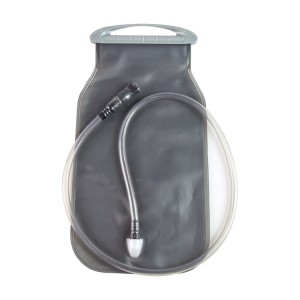
3.Regarding water bladder bag product export packaging information
Single Polybag,around 80 pieces into one carton,Carton Dimension:58cm*46cm*30CM,G.W:15kgs
4.What sports and activities can water bladder bag be used in?
We have advantages in marketing and channel expansion. Suppliers have established good cooperative relations, continuously improved workflows, improved efficiency and productivity, and provided customers with high -quality products and services.
1. Hiking and Camping: Water bladder bags are commonly used by hikers and campers as they allow for hands-free hydration while on the move.
2. Cycling: Cyclists often use water bladder bags as they can easily be attached to a backpack or bike frame, allowing for easy access to water while riding.
3. Running and Jogging: Water bladder bags are a popular choice for runners and joggers as they can be worn comfortably on the back and provide a steady supply of water during long-distance runs.
4. Climbing: Water bladder bags are a convenient option for climbers as they can easily be carried in a backpack and provide hydration while on the go.
5. Kayaking and Canoeing: Water bladder bags are a great choice for water sports like kayaking and canoeing as they can be easily stored in a waterproof bag and provide hydration while on the water.
6. Skiing and Snowboarding: Water bladder bags are commonly used by skiers and snowboarders as they can be worn under a jacket and provide hydration without having to stop and take off gear.
7. Team Sports: Water bladder bags can be used in team sports like soccer, football, and lacrosse as they can be worn under a jersey and provide hydration during games and practices.
8. CrossFit and Gym Workouts: Water bladder bags are a popular choice for CrossFit and gym workouts as they can be worn during high-intensity exercises and provide hydration without interrupting the workout.
9. Fishing: Water bladder bags are a convenient option for fishing trips as they can be easily carried in a backpack and provide hydration while out on the water.
10. Beach and Pool Activities: Water bladder bags can be used for beach and pool activities like swimming, surfing, and paddleboarding as they can be easily carried in a beach bag and provide hydration while enjoying the water.
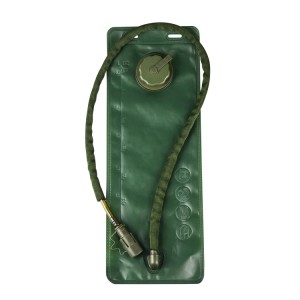
5.As a water bladder bag manufacturer, are your products easy to clean?
Our water bladder bag product is easy to clean: 100% BPA free, the water reservoir is fully reversible and top-rack dishwasher safe.
6.How to install water bladder bag into the backpack?
We maintain a certain amount of R&D investment every year and continuously improve operational efficiency to provide better services to our cooperative customers.
1. Prepare the backpack: Before installing the water bladder bag, make sure your backpack has a designated compartment or pocket for the bladder. This is usually located near the back panel of the backpack and has a small opening for the drinking tube.
2. Clean and fill the water bladder: Before inserting the water bladder into the backpack, make sure it is clean and filled with water. You can use warm soapy water to clean the bladder and rinse it thoroughly before filling it with water.
3. Insert the water bladder into the designated compartment: Carefully slide the filled water bladder into the designated compartment in your backpack. Make sure the opening of the bladder is facing the opening of the compartment.
4. Secure the bladder in place: Most backpacks have a hook or loop inside the compartment to secure the bladder in place. Make sure to fasten this to prevent the bladder from moving around while you are hiking or walking.
5. Thread the drinking tube through the backpack: Locate the small opening on the top or side of your backpack where the drinking tube will come out. Thread the tube through this opening and make sure it is easily accessible for drinking.
6. Attach the drinking tube to the shoulder strap: Many backpacks have a clip or loop on the shoulder strap to hold the drinking tube in place. Attach the tube to this clip or loop to keep it from dangling while you are hiking.
7. Adjust the straps: Once the water bladder is securely in place, adjust the straps on your backpack to ensure a comfortable fit. Make sure the weight of the bladder is evenly distributed and does not cause any discomfort.
8. Test the drinking tube: Before heading out on your hike, test the drinking tube to make sure it is working properly. Suck on the bite valve to see if water comes out and adjust the flow if needed.
Your water bladder bag is now installed and ready to use. Remember to clean and refill the bladder regularly to ensure a clean and safe water source while on your outdoor adventures.
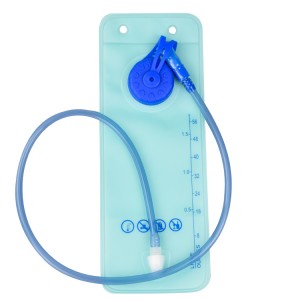
7.Are there any related accessories that can expand the functionality of water bladder bag?
We are a professional water bladder bag company dedicated to providing high quality products and services.
1. Insulated Tube Cover: This accessory helps to keep the water in the tube from freezing in cold weather, or from getting too hot in hot weather.
2. Bite Valve Cover: This cover protects the bite valve from dirt and debris, keeping it clean and hygienic.
3. Cleaning Kit: A cleaning kit specifically designed for water bladder bags can help to keep the bag and tube clean and free from bacteria and mold.
4. Quick Disconnect Hose: This accessory allows you to easily disconnect the hose from the bladder without having to remove the entire bladder from your pack.
5. Hydration Pack: A hydration pack is a backpack specifically designed to hold a water bladder, making it easier to carry and access while on the go.
6. Filter Adapter: A filter adapter allows you to connect a water filter directly to your water bladder, making it easy to filter water on the go.
7. Magnetic Clip: This accessory allows you to easily attach the bite valve to your pack strap, making it easily accessible while on the go.
8. Insulated Sleeve: An insulated sleeve can help to keep your water cool in hot weather, or prevent it from freezing in cold weather.
9. Sterilization Tablets: These tablets can be used to sterilize the water in your bladder, making it safe to drink from any water source.
10. Bladder Dryer: A bladder dryer helps to dry out the inside of your water bladder after use, preventing mold and bacteria growth.
8.What precautions should be taken before using water bladder bag?
We focus on teamwork and communication to achieve common goals, We attach great importance to this detail.
1. Clean and sanitize the bladder bag before first use: Before using the water bladder bag, it is important to clean and sanitize it properly. This will help remove any dirt, dust, or bacteria that may be present in the bag.
2. Check for any damages: Inspect the bladder bag for any damages such as tears, holes, or leaks. If you find any, do not use the bag and replace it with a new one.
3. Use clean water: Always use clean and safe drinking water to fill the bladder bag. Avoid using water from unknown sources or contaminated water.
4. Avoid using hot liquids: Water bladder bags are not designed to hold hot liquids. Avoid filling the bag with hot water as it can damage the bag and cause burns.
5. Use a compatible cleaning solution: If you need to clean the bladder bag, use a cleaning solution that is specifically designed for water bladder bags. Avoid using harsh chemicals or bleach as they can damage the bag and leave harmful residues.
6. Check the seals and connections: Make sure all the seals and connections are tight and secure before filling the bladder bag with water. Loose seals or connections can cause leaks and make the bag unusable.
7. Test for leaks: Before heading out, fill the bladder bag with water and check for any leaks. If you find any, fix them before using the bag.
8. Store the bag properly: When not in use, make sure to store the bladder bag in a clean and dry place. Avoid storing it in direct sunlight or extreme temperatures.
9. Clean and dry the bag after use: After using the bladder bag, make sure to clean and dry it properly before storing it. This will prevent the growth of bacteria and mold.
10. Replace the bladder bag regularly: It is recommended to replace the bladder bag every 6-12 months, depending on the frequency of use. This will ensure the bag is in good condition and safe to use.
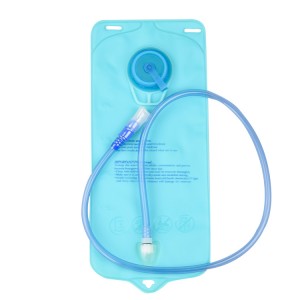
9.What are the specially designed features of water bladder bag?
We continuously upgrade our skills and knowledge to adapt to changing water bladder bag market needs.
1. Leak-proof Design: Water bladder bags are designed with a leak-proof construction to prevent any water from spilling out.
2. BPA-free Material: Most water bladder bags are made from BPA-free materials, ensuring that the water remains safe and free from harmful chemicals.
3. Wide Mouth Opening: The wide mouth opening of water bladder bags makes it easy to fill them with water and also allows for easy cleaning.
4. Insulated Tube: The tube that connects the bladder to the mouthpiece is often insulated to keep the water at a cool temperature, making it more refreshing to drink.
5. Bite Valve: The bite valve on the mouthpiece allows for easy and convenient drinking without having to stop and unscrew a cap.
6. Adjustable Straps: Water bladder bags come with adjustable straps that can be worn over the shoulders or attached to a backpack, making them easy to carry and use on the go.
7. Hydration Capacity: Water bladder bags come in various sizes and capacities, ranging from 1 liter to 3 liters, allowing users to choose the right size for their needs.
8. Durable Material: Water bladder bags are made from durable materials such as TPU or PVC, which can withstand rough outdoor conditions.
9. Easy to Clean: Most water bladder bags are designed to be easy to clean, with features such as a wide opening and detachable tubes for thorough cleaning.
10. Lightweight and Compact: Water bladder bags are lightweight and can be easily rolled up or folded when not in use, making them convenient to carry and store.
10.What are the key points to pay attention to when purchasing water bladder bag?
We maintain a stable growth through reasonable capital operations, focus on industry development trends and cutting -edge technologies, and focus on product quality and safety performance.
1. Material: The material of the water bladder bag should be durable, leak-proof, and safe for storing drinking water. Look for bags made of BPA-free, food-grade materials such as TPU or PVC.
2. Capacity: Consider the capacity of the water bladder bag based on your needs. If you are using it for outdoor activities, a larger capacity (2-3 liters) may be more suitable. For everyday use, a smaller capacity (1-2 liters) may be sufficient.
3. Size and weight: The size and weight of the water bladder bag should be compact and lightweight, making it easy to carry and store.
4. Bite valve: The bite valve is an important component of the water bladder bag as it controls the flow of water. Look for a bite valve that is easy to use, leak-proof, and has a dust cover to keep it clean.
5. Insulation: If you plan on using the water bladder bag for outdoor activities, consider purchasing one with insulation to keep your water cool in hot weather.
6. Compatibility: Make sure the water bladder bag is compatible with your hydration pack or backpack. Some bags may have specific attachments or sizes that may not fit all packs.
7. Cleaning and maintenance: Look for water bladder bags that are easy to clean and maintain. Some bags may have a wide opening for easy cleaning, while others may come with cleaning kits.
8. Durability: Consider the durability of the water bladder bag, especially if you plan on using it for outdoor activities. Look for bags with reinforced seams and strong materials that can withstand rough use.
9. Price: Water bladder bags come in a range of prices, so consider your budget and choose one that offers the best value for money.
10. Brand and reviews: It is always a good idea to research the brand and read reviews from other users before making a purchase. This can give you an idea of the quality and performance of the water bladder bag.
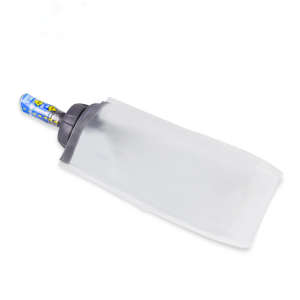
Post time: Feb-28-2024

